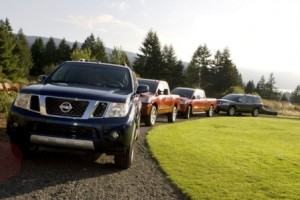Nissan is conducting what it calls a “Voluntary Service Campaign” on a 9,000 four-wheel-drive Armada, Frontier, Pathfinder, Titans, Xterra and Infiniti QX56 2010 models to inspect the front driveshaft.
This is not a safety recall but a service action of the kind that has been criticized by safety advocates. (Click Here.)
Some of these front driveshafts made by Dana have a yoke manufactured out of specification, which may cause cracks in the critical connection between the yoke, which holds a universal joint, and the tubular shaft.
Nissan maintains that the vehicles are safe to drive.
“Even in the event the front propeller [drive] shaft was to fail, the vehicle would continue to operate in the normal two-wheel-drive mode. A loud noise would be heard but control of the vehicle would not be affected,” Nissan said in a statement, after we requested comment.
People with knowledge of the issue also clarified that if the driveshaft fails it cannot make contact with the ground and cause “pole vaulting” since there is a cross member below it. I originally speculated, incorrectly, that this would be possible in the first version of this story.
Nissan is notifying owners of all potentially affected vehicles. They will be told to bring their vehicles to an authorized Nissan dealer. The dealer will inspect the front driveshaft, and replace it – if cracks are found where the yoke for the universal joint is connected to the shaft
This differs from the Toyota approach to the same problem. Toyota immediately instituted a safety recall on 2010 model Tacoma trucks that use similar Dana driveshafts going to the rear wheels after being informed in February by the component supplier of the cracking defect, which resulted from a faulty manufacturing process.
Ford Motor Company, which also uses the same potentially defective Dana driveshafts on Escape, Mercury Mariner and Mazda Tribute SUVs, has concluded that no action is needed on its vehicles since the driveshaft in question only powers the rear wheels a small percentage of the time for what are front-wheel-drive vehicles.
So three automakers using the same parts have taken three different approaches to a potential safety defect. The nuance here is in the potential consequence of the failure, which are not being disclosed in either company statements or NHTSA documents. This legalistic approach makes it impossible for news organizations to discern the nature of the threat, if one exists at all. Small wonder then that consumers are confused about safety regulations and their effectiveness.
This was one of the core issues that emerged during Congressional hearings about the Toyota pedal entrapment and unintended acceleration recalls and the National Highway Traffic Safety Administration’s relationship with automakers, which allows for negotiation about how many vehicles will be recalled or whether a service action will do, or if anything is done at all.
NHTSA is under attack by consumer organizations and safety advocates for its inaction and closing of multiple Toyota investigations without recalls, which, as we now know, ultimately, resulted in serious injuries and deaths on Toyota vehicles.
Recalls were finally ordered after adverse publicity about more than 60, alleged, deaths occurred because of safety related defects. Moreover, it took a visit to Japan by the former acting administrator of NHTSA to force a Toyota recall, since Toyota’s American executives had no power to do so.
No surprise then that NHTSA has been called a “lapdog” for the auto industry by critics. In the 38 years since NHTSA has had recall authority, not once has the agency ordered a recall from an automaker.
NHTSA says its negotiated voluntary approach with automakers saves time and legal fees, assertions that were met with considerable skepticism yesterday at a Congressional oversight hearing on its effectiveness as a safety watchdog. (Click Here.)


I confirmed this was the exact issue with my 2008 Nissan Xterra with the dealership. It was covered under warranty. I have a skid plate in place under the front drive shaft, so there was no potential for it to hit the ground….but it does make a god-awful sound when it fails.
Jason: Thanks – It turns out the shaft is also above a cross member so it can’t hit the ground. It’s no doubt noisy, if it fails…